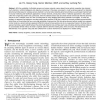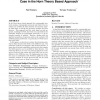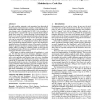243 search results - page 45 / 49 » How to Solve It Automatically: Selection Among Problem Solvi... |
TKDE
2008
13 years 7 months ago
2008
With the availability of affordable sensors and sensor networks, sensor-based human-activity recognition has attracted much attention in artificial intelligence and ubiquitous comp...
CCS
2008
ACM
13 years 9 months ago
2008
ACM
In the Horn theory based approach for cryptographic protocol analysis, cryptographic protocols and (Dolev-Yao) intruders are modeled by Horn theories and security analysis boils d...
BMCBI
2010
13 years 7 months ago
2010
Background: The quality of automated gene prediction in microbial organisms has improved steadily over the past decade, but there is still room for improvement. Increasing the num...
GECCO
2007
Springer
14 years 1 months ago
2007
Springer
This paper describes the application of evolutionary search to the problem of Flash memory wear-out. The operating parameters of Flash memory are notoriously difficult to determin...
POPL
2009
ACM
14 years 8 months ago
2009
ACM
We study modular, automatic code generation from hierarchical block diagrams with synchronous semantics. Such diagrams are the fundamental model behind widespread tools in the emb...



